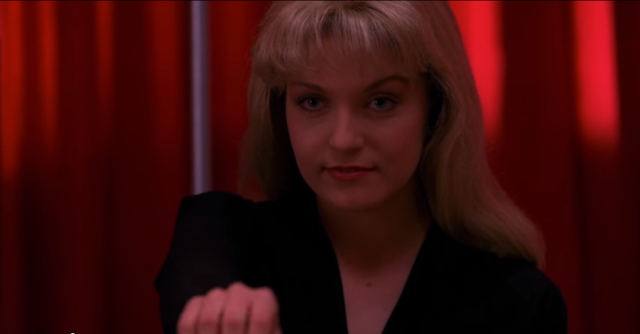So the cryptic teasers posted on Twitter by Mark Frost and David Lynch have substance: Twin Peaks will be returning to television screens 25 years after its cancellation. The new series will be a nine-episode run on US premium cable network Showtime. Again Lynch and Frost are to be united as key creative personnel.
For those unaware of Twin Peaks, it became a cultural phenomenon in the US (and beyond) in the early 90s. The series narrative initially revolved around the investigation of the murder of the seemingly idyllic prom queen, Laura Palmer (Sheryl Lee), by FBI special agent Dale Cooper (Kyle Maclachlan). It was set in the equally idyllic Pacific North West town that gave the series its name. But as the narrative progressed and surfaces were scratched, the town and its surrounding areas revealed many dark secrets. Even the owls were not what they seemed.
Twin Peaks was axed after just 30 episodes, ending on an unresolved cliff-hanger where agent Cooper had become possessed by the evil spirit BOB after escaping from the Black Lodge (a sequence that remains one of the most abstract, inventive and disturbing sequences ever seen on television). Similar denials of closure are characteristic of programmes that attract enduring fan communities (The Prisoner and Blake’s 7 immediately spring to mind) and Twin Peaks is no exception. Deferring resolution allows fans the space to speculate about what happened after and to draw their own conclusions.
Such activities assist in maintaining a series’ visibility and, in the years since its untimely cancellation, Twin Peaks remains extraordinarily well known. The programme still has a healthy fan community through yearly conventions and events and, although news of the programme’s return has generated some mildly-dissenting voices, the announcement has generally received high levels of enthusiasm. Twin Peaks’ reputation has also endured as a reference point for multiple television series as diverse as The Simpsons and AMC’s remake of The Killing, though, demonstrating its wider legacy within popular culture.
Industry shifts
Twin Peaks caught the attention of future directors and fans because of its originality; because it was such a product of its time. It was commissioned by ABC in response to declining audiences that were the result of multiple shifts that were affecting the TV industry throughout the 1980s when there was suddenly much greater choice. It was the slick visual style and Hollywood associations of the show that helped distinguish it from its peers. Twin Peaks was addressed primarily towards affluent, “quality” viewers who wouldn’t regularly watch television.
Such appeals were even encoded into the series itself in the form of a spoof soap opera called Invitation to Love that enthrals (primarily female) characters. Such features required the show’s audience to get the joke, and reflect on the excesses of equivalent prime-time soaps such as Dallas and Dynasty. This makes Twin Peaks not only of its time but also something of a historical artefact.
But it hasn’t lost its relevance, and it can still be considered timeless. Such jokes and tropes continue to echo if you watch the series now, 20 years after those specific cultural references resonated. And this is particularly down to that same idea that originated with Twin Peaks: TV that “isn’t TV”. This idea mirrors contemporary discourses of “quality” television. Retrospective reflections from former cast and crew members regularly imply that the series remains unique in comparison to its peers in the same way that HBO series such as The Sopranos, Sex and the City and, more recently, Game of Thrones are marketed as “not TV”. A recent article for Salon stressed such parallels by arguing that without Twin Peaks there would have been no Breaking Bad or Mad Men. Twin Peaks appears timeless because it erodes distinctions between TV production trends then – and now.
Perfect timing
Twin Peaks’ return is also perfectly timed. This is because similar shifts in audience behaviour are happening again. Rather than VCRs, satellite and cable, streaming and on-demand services such as Netflix are reconfiguring how people watch TV. While it remains to be seen whether Twin Peaks’ return will spoof these trends (Invitation to Stream, perhaps?), TV drama is responding to these changes by providing more edgy content that targets specific niche audiences. Just look at Hannibal, True Detective or the aforementioned Game of Thrones. Twin Peaks certainly fits the bill here. The current climate may be well suited to the series’ at times complex and abstract exploration of philosophical issues such as the concepts of good and evil, or the individual psyche.
And anniversaries are more popular than ever, a by-product of the difficulty in holding down audiences among an avalanche of content. This spring saw publicity events take place in LA to mark the tenth anniversary of Lost’s debut on US television while the UK (and beyond) also recently saw year-long celebrations to commemorate the 50th anniversary of Doctor Who. Commemorating Twin Peaks’ 25th anniversary with a new series in 2016 (which coincides with its cancellation) is part of this trend.
Those composing lists and dreaming about which original characters will or must return may be disappointed – the new series will have to attract and sustain a new audience alongside entertaining its established fans. Let’s wait and see if the furore of the early 90s will happen again. Time, as always, will tell.

